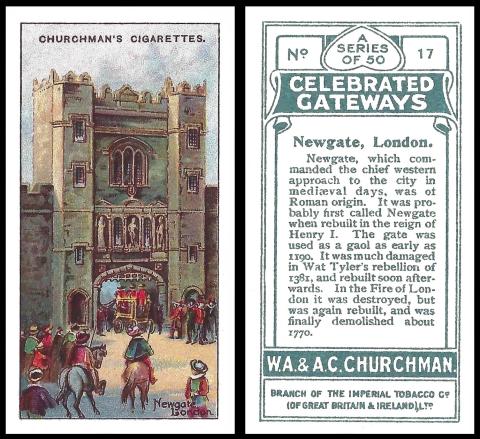
Now this is a curious connection, but in this country porridge seems to have picked up a certain link with prison. Some of us well remember the television show "Porridge", with Ronnie Barker, and if not it is mentioned on card 11 of Golden Wonder "TV All Stars".
The reason was that in earlier times porridge formed the breakfast for prisoners. This was because it was slow release food, so they did not have to stop working until lunchtime, and also it was good for them health-wise. You may be wondering why this mattered, but at that time the prisoners worked, either in the local farms, building roads, etc, and a healthy inmate would "earn his keep", which is another phrase we get from prisons.
One of the most feared prisons was Newgate, in the City of London, which was built in the twelfth century. It is even mentioned on our card, where it says that "the gate was used as a gaol as early as 1190". Actually it seems now to be cited as 1188. The site on which it stood was part of Roman London, and it was a gate in the wall that surrounded Londinium. Our card again provides us with the information of what happened later, that "it was probably first called Newgate when rebuilt in the reign of Henry I . . . was much damaged in Wat Tyler`s rebellion of 1381, and rebuilt soon afterwards. In the Fire of London t was destroyed but was again rebuilt, and was finally demolished about 1770. However they must have meant the version showing on that card, because Newgate remained in use until 1902.
Some intriguing facts are that a separate area for women prisoners was built in 1406 - that the money for the 1422 alterations was provided from a legacy left for that purpose by Dick Whittington - and that attached to the prison for much of its life were courtrooms, where the prisoner could plead their case on their arrest and then be tried and sent next door, or released. The courtrooms seem to have been sited to the side of the prison, because they became known as the old bailey, and so they remain to this day. The reason for this thought is that a bailey is the proper name for the exterior of a castle or wall, often one which slopes down to a moat, and as the Roman walls were built for defence, they would have done just this. Today the Old Bailey premises cover the site where Newgate used to stand and have replaced them entirely.
This card is the scarcer Churchman version of Celebrated Gateways. The John Player version was issued quite a long way earlier, in 1909, but the Churchman not until 1925. Our original Churchman reference book, RB.10, issued in 1948, describes ours as :
30. April 1925. CELEBRATED GATEWAYS (titled series). Size 2 11/16" x 1 7/16" or 67 x 36 m/m. Numbered 1-50. Fronts lithographed in colour. Backs in dark green, with descriptions. Printed by Mardon, Son & Hall. Also issued by Players.
Our World Tobacco Issues Indexes both list the set as "CELEBRATED GATEWAYS. Sm. Nd. (50). See H.347".
And H.347 leads us to the Handbook, where the text is :
H.347. CELEBRATED GATEWAYS. (titled series) Fronts in colour. Numbered series of 50.
Pre-1919 Player
Post 1919 Churchman
